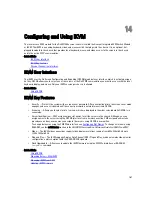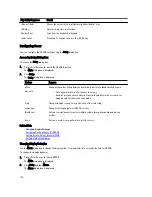
Fabric verification for server IOMs and MCs is performed only when the chassis is powered on. When the
chassis is on standby power, the iDRACs on the server modules remain powered off and thus are unable to
report the server's MC fabric type. The MC fabric type may not be reported in the CMC user interface until the
iDRAC on the server is powered on. Additionally, if the chassis is powered on, fabric verification is performed
when a server or IOM is inserted (optional). If a fabric mismatch is detected, the server or IOM is allowed to
power on and the status LED flashes Amber.
Invalid Configurations
There are three types of invalid configurations:
•
Invalid MC or LOM configuration, where a newly installed server’s fabric type is different from the existing IOM
fabric, that is, a single server’s LOM or MC is not supported by its corresponding IOM. In this case, all the other
servers in the chassis are running, but the server with the mismatched MC card cannot be power on. The power
button on the server flashes Amber to alert a fabric mismatch.
•
Invalid IOM-MC configuration, where a newly installed IOM’s fabric type and the resident MC’s fabric types do
not match or are incompatible. The mismatched IOM is held in the power-off state. CMC adds an entry to CMC
and hardware logs noting the invalid configuration and specifying the IOM name. CMC causes the error LED on
the offending IOM to blink. If CMC is configured to send alerts, it sends e-mail and/or SNMP alerts for this event.
•
Invalid IOM-IOM configuration, where a newly installed IOM has a different or incompatible fabric type from an
IOM already installed in its group. CMC holds the newly installed IOM in powered-off state, causes the IOM’s
error LED to blink, and logs entries in CMC and hardware logs about the mismatch.
Fresh Power-up Scenario
When the chassis is plugged in and powered up, the I/O modules have priority over the servers. The first IOM in each
group is allowed to power up before the others. At this time, verification of their fabric types is not performed. If there is
no IOM on the first slot of a group, the module on the second slot of that group powers up. If both slots have IOMs, the
module in the second slot is compared for consistency against the one in the first.
After the IOMs power up, the servers power up, and CMC verifies the servers for fabric consistency.
A pass-through module and switch are allowed in the same group if their fabric is identical. Switches and pass-through
modules can exist in the same group even if they are manufactured by different vendors.
Monitoring IOM Health
For information about monitoring IOM health, see
Viewing Information and Health Status of All IOMs
and
Viewing
Information and Health Status For Individual IOM
.
Configuring Network Settings for IOM(s)
You can specify the network settings for the interface used to manage the IOM. For Ethernet switches, the out-of-band
management port (IP address) is configured. The in-band management port (that is, VLAN1) is not configured using this
interface.
Before configuring the network settings for the IOM(s), make sure the IOM is powered on.
To configure the network setting, you must have:
•
Fabric A Administrator privileges to configure IOMs in Group A.
•
Fabric B Administrator privileges to configure IOMs in Group B.
•
Fabric C Administrator privileges to configure IOMs in Group C.
161
Содержание Chassis Management Controller
Страница 1: ...Dell Chassis Management Controller Firmware Version 4 3 User s Guide ...
Страница 42: ...42 ...
Страница 56: ...56 ...
Страница 84: ...84 ...
Страница 98: ...98 ...
Страница 104: ...104 ...
Страница 130: ...130 ...
Страница 136: ...136 ...
Страница 200: ...200 ...
Страница 214: ...214 ...
















































